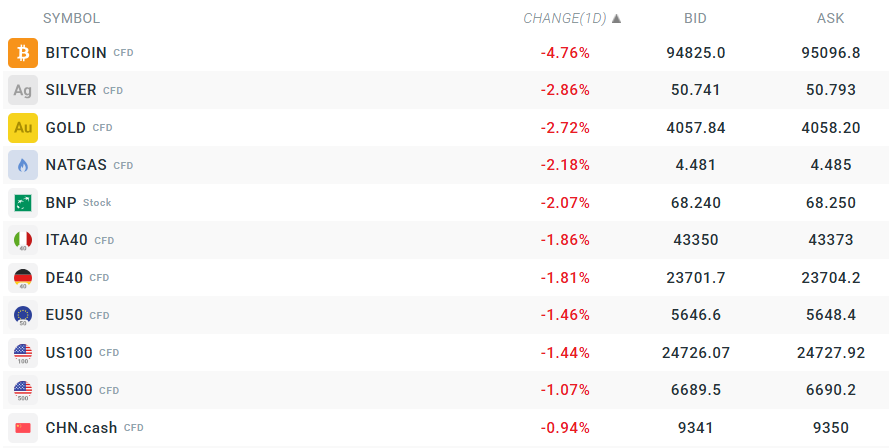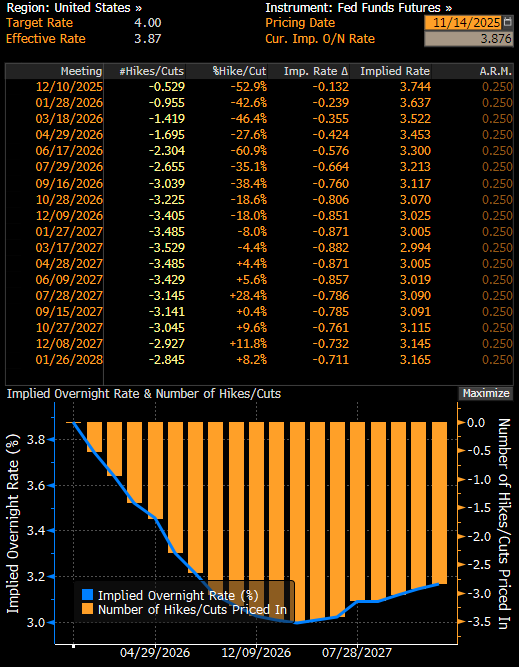Friday, 14 November, turns out to be a day of profound reckoning on global financial markets. With investor sentiment deteriorating, we are seeing a massive sell-off of virtually all asset classes, from equities to commodities and cryptocurrencies, signalling a significant shift in investors' approach to risk.

Market sentiment stands on a knife's edge as US markets prepare to open after a bloodbath across European and Asian bourses. The critical question investors face is whether the session opening on Wall Street will mark a capitulation point—where panic selling exhausts itself and oversold conditions trigger reversal buying—or whether the momentum of weakness carries through and deepens the rout. Source: xStation
The stock market is experiencing one of its strongest sell-offs since April, when investors faced Donald Trump's tariff panic. The declines in S&P 500 and NASDAQ 100 futures are due to overlapping fundamental and macroeconomic factors. Firstly, the technology and artificial intelligence sector remains in the spotlight – growing doubts about company valuations and real returns on billion-pound investments in AI are creating selling pressure, particularly among companies such as Nvidia, Broadcom and AMD. Secondly, declining expectations for Fed rate cuts – the chance of a December decision has fallen from 95% to around 50% – combined with the central bank's hawkish tone are increasing risk aversion.

Source: Bloomberg Financial LP
In addition, the market is reacting to political and macroeconomic uncertainty. The historically long government shutdown in the US has caused delays in the publication of key data, making it difficult to assess the state of the economy, while in the UK, uncertainty over how to finance the fiscal gap is weakening the pound. Weaker data from China – factory output rose by only 4.9% year-on-year, the slowest pace in 14 months – is adding to global concerns.
The current sell-off is resulting in a rising VIX volatility index and a rotation of capital from growth stocks to more defensive assets. In the short term, markets remain cautious. Further declines are possible if new negative macro signals emerge or the Fed maintains its hawkish stance.
Today's session is not so normal, as the usual "safe havens" such as gold are not doing any better. The precious metal is currently down 2% and has fallen below USD 4,100 per ounce.
Another issue is Bitcoin, which is down 5% today alone and has fallen below 95,000 USD. This is the deepest decline for this cryptocurrency since the beginning of the year, when it lost 33% from its previous peak. At the moment, BTC has already lost 25% from its peak in early October.

The latest series of sell-offs seems to be particularly affecting Bitcoin, which has almost wiped out all of this year's gains. Source: Bloomberg Financial LP
BREAKING: Lower Unemployment in Canada🍁USDCAD sharply declines📉
DE40: Adequate data, Mild growth
BREAKING: Euro-zone GDP slightly above expectations!📈 EURUSD remains stable
Chart of the day: CHN.cash (05.12.2025)
This content has been created by XTB S.A. This service is provided by XTB S.A., with its registered office in Warsaw, at Prosta 67, 00-838 Warsaw, Poland, entered in the register of entrepreneurs of the National Court Register (Krajowy Rejestr Sądowy) conducted by District Court for the Capital City of Warsaw, XII Commercial Division of the National Court Register under KRS number 0000217580, REGON number 015803782 and Tax Identification Number (NIP) 527-24-43-955, with the fully paid up share capital in the amount of PLN 5.869.181,75. XTB S.A. conducts brokerage activities on the basis of the license granted by Polish Securities and Exchange Commission on 8th November 2005 No. DDM-M-4021-57-1/2005 and is supervised by Polish Supervision Authority.


